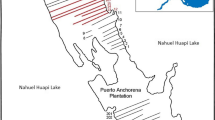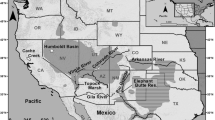Abstract
Phenological documentation and plant invasion are key contemporary issues in the biological sciences. Recognizing this, the present paper describes the phenological stages of an invasive species, Sapium sebiferum (L.) Roxb. A tree of the species was marked, and daily visits were made for recording its phenology. The Biologische Bundesanstalt, Bundessortenamt and CHemical industry (BBCH) scale was used for documenting the same. Of the total ten principal stages, eight were observed in the species. These stages started with bud development (stage 01) in the month of March and ended with leaf fall (stage 97) in the month of December. Descriptions of the phenological stages and their dates are provided in the text. It is hoped that such a phenological scale will be helpful in managing plant invasion.


Similar content being viewed by others
References
Ahmad Nazarudin, M. R., Tsan, F. Y., Normaniza, O., & Adzami, Y. (2012). Phenological growth stages of the golden penda tree (Xanthostemon chrysanthus). Annals of Applied Biology, 161, 12–15.
Barrilleaux, T. C., & Grace, J. B. (2000). Growth and invasive potential of Sapium sebiferum (Euphorbiaceae) within the coastal prairie region: the effects of soil moisture regime. American journal of Botany, 87, 1099–1106.
Bruce, K. A., Cameron, G. N., & Harcombe, P. A. (1995). Initiation of a new woodland type on the Texas coastal prairie by the Chinese tallow tree (Sapium sebiferum (L.) Roxb.). Bulletin of the Torrey Botanical Club, 122, 215–225.
Bruce, K. A., Cameron, G. N., Harcombe, P. A., & Jubinsky, G. (1997). Introduction, impact on native habitats, and management of a woody invader, the Chinese tallow tree, Sapium sebiferum (L.) Roxb. Natural Areas Journal, 17, 255–260.
Chuine, I., Yiou, P., Viovy, N., Seguin, B., Daux, V., & Ladurie, L. R. E. (2004). Grape ripening as a past climate indicator. Nature, 432, 289–290.
Correll, D. S., & Johnston, M. C. (1979). Manual of the vascular plants of Texas (2nd printing). Dallas: The University of Texas.
Feller, C., Richter, E., Smolders, T., & Wichura, A. (2012). Phenological growth stages of edible asparagus (Asparagus officinalis): codification and description according to the BBCH scale. Annals of Applied Biology, 160, 174–180.
Fitter, A. H., & Fitter, R. S. R. (2002). Rapid changes in flowering time in British plants. Science, 296, 1689–1691.
Forero, D. C., Hormaza, P., & Romero, H. M. (2012). Phenological growth stages of African oil palm (Elaeis guineensis). Annals of Applied Biology, 160, 56–65.
Godoy, O., Richardson, D. M., Valladares, F., & Castro-Dı´ez, P. (2009). Flowering phenology of invasive alien plant species compared with native species in three Mediterranean-type ecosystems. Annals of Botany, 103, 485–494.
Jaryan, V., Chopra, S., Uniyal, S. K., & Singh, R. D. (2007). Spreading fast yet unnoticed: are we in for another invasion? Current Science, 93, 483–484.
Jaryan, V., Uniyal, S. K., Kumar, A., Gupta, R. C., Parkash, O., & Singh, R. D. (2013a). Distribution characteristics of Sapium sebiferum (L.) Roxb.—an invasive tree species in Himachal Pradesh. Proceedings of Indian National Science Academy, 79, 215–234.
Jaryan, V., Datta, A., Uniyal, S. K., Kumar, A., Gupta, R. C., & Singh, R. D. (2013b). Modelling potential distribution of Sapium sebiferum—an invasive tree species in Western Himalaya. Current Science, 105, 1282–1288.
Jubinsky, G. (1993). Chinese tallow gets worse! The Palmetto, 13, 3.
Kollmann, J., & Bañuelos, M. J. (2004). Latitudinal trends in growth and phenology of the invasive alien plant Impatiens glandulifera (Balsaminaceae). Diversity and Distributions, 10, 377–385.
Legua, P., Martínez, J. J., Melgarejo, P., Martínez, R., & Hernández, F. (2013). Phenological growth stages of caper plant (Capparis spinosa L.) according to the Biologische Bundesanstalt, Bundessortenamt and CHemical scale. Annals of Applied Biology, 163, 135–141.
Lieth, H. H. (1976). Contributions to phenology seasonality research. Int. J. Biometeorology, 20, 197–199.
Lin, W. C., Chen, A. C., Tseng, C. J., & Huang, S. G. (1958). An investigation and study of Chinese tallow tree in Taiwan (Sapium sebiferum Roxb.). Bulletin of Taiwan Forestry Research Institute, 57, 32–37.
Meier, U. (2001). Growth stages of mono-and dicotyledonous plants—BBCH Monograph. The BBCH codes are on the homepage of the Julius Kühn-Institute (JKI). http://www.jki.bund.de–publications. BBCH-scale as PDF-file in English
Meier, U., Bleiholder, H., Buhr, L., Feller, C., Hack, H., He, M., et al. (2009). The BBCH system to coding the phenological growth stages of plants—history and publications. Journal Für Kulturpflanzen, 61, 41–52.
Menzel, A., Sparks, T. H., Estrella, N., Koch, E., Aasa, A., et al. (2006). European phenological response to climate change matches the warming pattern. Global Change Biology, 12, 1969–1976.
Mounzer, O. H., Conejero, W., Nicolas, E., Abrisqueta, I., Garcia-Orellana, T. L. M., Vera, J., et al. (2008). Growth pattern and phenological stages of early-maturing peach trees under a Mediterranean climate. HortScience, 43, 1813–1818.
Perglová, I., Perg, J., & Pyšek, P. (2006). Flowering phenology and reproductive effort of the invasive alien plant Heracleum mantegazzianum. Preslia, 78, 265–285.
Primack, R. B., & Miller-Rushing, A. J. (2011). Broadening the study of phenology and climate change. New Phytologist, 191, 307–309.
Pysek, P., Richardson, D. M., Rejmanek, M., Webster, G. L., Williamson, M., & Kirschner, J. (2004). Alien plants in checklists and flora: towards better communication between taxonomists and ecologists. Taxon, 53, 131–143.
Rybski, D., Holsten, A., & Kropp, J. P. (2011). Towards a unified characterization of phenological phases: fluctuations and correlations with temperature. Physica A, 390, 680–688.
Sharma, C. M., & Khanduri, V. P. (2007). Vegetative and reproductive phenophases in Aesculus indica Colebr. at two different altitudes in Himalayan forests. Current Science, 92, 216–225.
Sharma, S., Rikhari, H. C., & Palni, L. M. S. (1996). Adoption of a potential plantation tree crop as an agroforestry species but for the wrong reasons: a case study of the Chinese tallow tree from central Himalaya. International Tree Crops Journal, 9, 37–45.
Singh, K., Kapur, S. K., & Sarin, Y. K. (1993). Domestication of Sapium sebiferum under Jammu conditions. Indian Forester, 119, 36–42.
Vela, P., Salinero, C., & Sainz, M. J. (2013). Phenological growth stages of Camellia japonica. Annals of Applied Biology, 162, 182–190.
Wolkovich, E. M., & Cleland, E. E. (2011). The phenology of plant invasions: a community ecology perspective. Frontiers in Ecology and the Environment, 9, 287–294.
Acknowledgments
The authors are thankful to the Director, CSIR-IHBT, Palampur, for the facilities and support. VJ thanks CSIR for the SRF scholarship. The faculty and members of the IHBT herbarium are acknowledged for their valuable help. This is IHBT communication no. 3552. The authors acknowledge the constructive comments and suggestions of the editor and two anonymous reviewers that helped in improving the manuscript.
Author information
Authors and Affiliations
Corresponding author
Rights and permissions
About this article
Cite this article
Jaryan, V., Uniyal, S.K., Gupta, R.C. et al. Phenological documentation of an invasive species, Sapium sebiferum (L.) Roxb.. Environ Monit Assess 186, 4423–4429 (2014). https://doi.org/10.1007/s10661-014-3708-7
Received:
Accepted:
Published:
Issue Date:
DOI: https://doi.org/10.1007/s10661-014-3708-7




